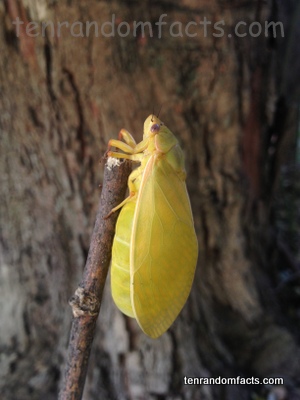Buzz… Buzz… Buzz Buzz Buzz… BuzzBuzzBuzz… go the cicadas.
- ‘Cicada’ is a Latin word meaning ‘tree cricket’, and the insect is also known as ‘cicala’ or ‘cicale’, and is sometimes mistakenly called a ‘locust’.
- Cicadas are from the family Cicadoidea, which is within the order Hemiptera, the family of true bugs such as aphids.
- There are 2500 official species of cicadas, with more of the insects that still need to be classified, and they are found on every continent excluding Antarctica.
- Cicadas are often coloured in dark shades like brown and black, although other colours exist in some species including green, blue and orange.
- Cicadas generally have two sets of wings, widely placed eyes, three ocelli (small eyes) and two antennae, and a sharp proboscis used to drink tree sap.
- Cicadas can affect the growth of the trees they feed on, and can cause damage from the laying of their eggs.
- Cicadas are eaten all around the world, particularly China, Malaysia, Burma, Latin America, Congo and, historically, Ancient Greece.
- Male cicadas can make very loud buzzing songs, used as a warning or mating call, by rubbing their musical membranes, or tymbals, and perform the most and the best on hot months and hot days.
- Cicadas live most of their life, which can be 2-17 years depending on the species, burrowed underground as a nymph that feed on the juice of roots, and later they emerge to the surface, malt and generally live for 2 to 6 more weeks.
- Cicadas are preyed on by birds, squirrels and bass fish, along with wasps who use them to feed their young.
Bibliography:
Britton D, Cicada: Superfamily Cicadoidea, 2012, Australian Museum, <http://australianmuseum.net.au/Cicadas-Superfamily-Cicadoidea>
Cicada, 2013, Wikipedia, <http://en.wikipedia.org/wiki/Cicada>







